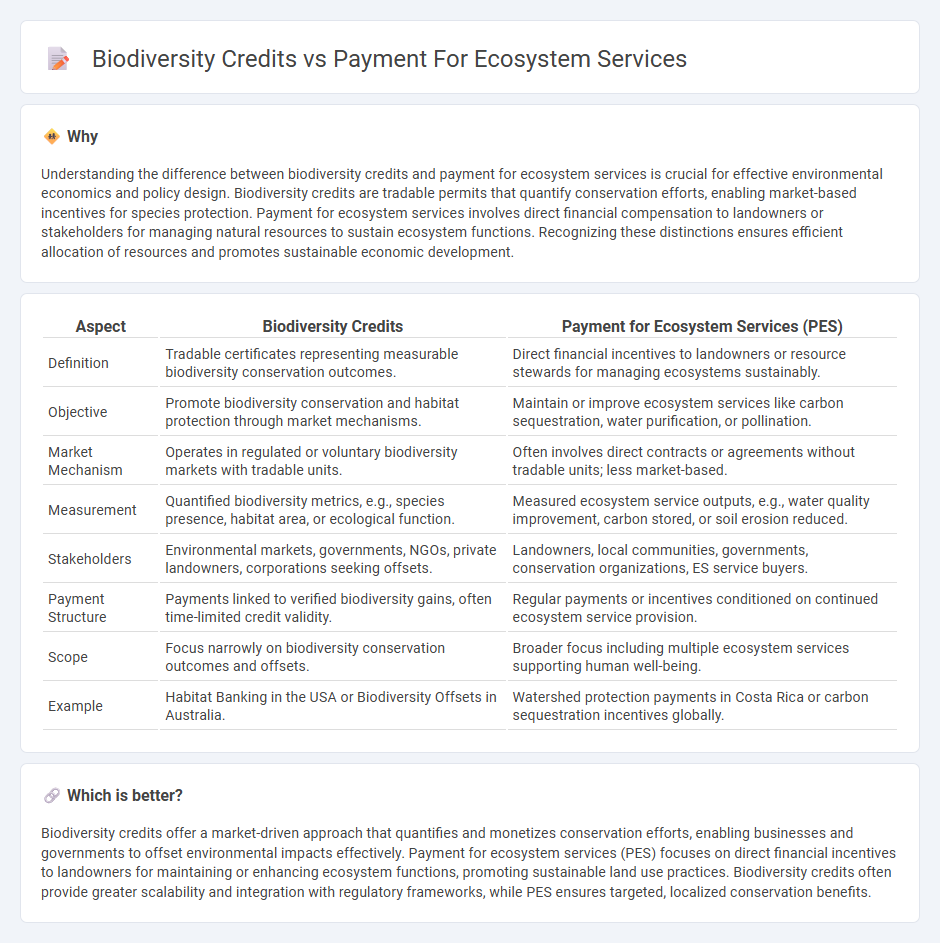
Biodiversity credits represent tradable certificates that quantify and monetize the preservation of specific species or habitats, incentivizing conservation through market mechanisms. Payment for ecosystem services (PES) involves direct financial compensation to landowners or communities for managing natural resources sustainably to maintain ecosystem functions like water purification and carbon sequestration. Explore the comparative effectiveness and economic impacts of biodiversity credits and PES schemes to understand their roles in advancing sustainable development.
Why it is important
Understanding the difference between biodiversity credits and payment for ecosystem services is crucial for effective environmental economics and policy design. Biodiversity credits are tradable permits that quantify conservation efforts, enabling market-based incentives for species protection. Payment for ecosystem services involves direct financial compensation to landowners or stakeholders for managing natural resources to sustain ecosystem functions. Recognizing these distinctions ensures efficient allocation of resources and promotes sustainable economic development.
Comparison Table
| Aspect | Biodiversity Credits | Payment for Ecosystem Services (PES) |
|---|---|---|
| Definition | Tradable certificates representing measurable biodiversity conservation outcomes. | Direct financial incentives to landowners or resource stewards for managing ecosystems sustainably. |
| Objective | Promote biodiversity conservation and habitat protection through market mechanisms. | Maintain or improve ecosystem services like carbon sequestration, water purification, or pollination. |
| Market Mechanism | Operates in regulated or voluntary biodiversity markets with tradable units. | Often involves direct contracts or agreements without tradable units; less market-based. |
| Measurement | Quantified biodiversity metrics, e.g., species presence, habitat area, or ecological function. | Measured ecosystem service outputs, e.g., water quality improvement, carbon stored, or soil erosion reduced. |
| Stakeholders | Environmental markets, governments, NGOs, private landowners, corporations seeking offsets. | Landowners, local communities, governments, conservation organizations, ES service buyers. |
| Payment Structure | Payments linked to verified biodiversity gains, often time-limited credit validity. | Regular payments or incentives conditioned on continued ecosystem service provision. |
| Scope | Focus narrowly on biodiversity conservation outcomes and offsets. | Broader focus including multiple ecosystem services supporting human well-being. |
| Example | Habitat Banking in the USA or Biodiversity Offsets in Australia. | Watershed protection payments in Costa Rica or carbon sequestration incentives globally. |
Which is better?
Biodiversity credits offer a market-driven approach that quantifies and monetizes conservation efforts, enabling businesses and governments to offset environmental impacts effectively. Payment for ecosystem services (PES) focuses on direct financial incentives to landowners for maintaining or enhancing ecosystem functions, promoting sustainable land use practices. Biodiversity credits often provide greater scalability and integration with regulatory frameworks, while PES ensures targeted, localized conservation benefits.
Connection
Biodiversity credits and payment for ecosystem services (PES) are linked through their role in monetizing environmental benefits to promote conservation. Biodiversity credits provide a market-based approach where entities pay to offset their environmental impact by financing conservation projects, while PES incentivizes landowners or communities to maintain or enhance ecosystem functions that deliver services such as clean water, climate regulation, and habitat preservation. Both mechanisms integrate economic valuation into biodiversity conservation, encouraging sustainable resource management and aligning financial interests with ecological health.
Key Terms
Valuation
Payment for ecosystem services (PES) involves direct financial incentives to landowners or resource stewards for maintaining or enhancing ecosystem functions like water purification, carbon sequestration, or soil fertility, emphasizing ecosystem service valuation through quantifiable ecological benefits. Biodiversity credits, on the other hand, center on monetizing conservation outcomes linked to specific species or habitats, assigning value to biodiversity based on species richness, rarity, or ecological significance, often integrated into regulatory frameworks for offsetting impacts of development. Explore how valuation methodologies differ and influence conservation financing by delving deeper into the economic and ecological metrics behind PES and biodiversity credit systems.
Incentives
Payments for Ecosystem Services (PES) provide direct financial incentives to landowners or resource stewards for maintaining or enhancing ecosystem functions, such as carbon sequestration, water purification, or habitat conservation. Biodiversity credits function as tradable permits that quantify and monetize biodiversity gains, creating market-driven incentives for developers and businesses to offset their environmental impacts. Explore how these mechanisms drive conservation efforts through innovative economic incentives and market-based solutions.
Market mechanisms
Payment for Ecosystem Services (PES) and biodiversity credits are market-based mechanisms designed to incentivize conservation and sustainable land use. PES schemes typically involve direct transactions where beneficiaries pay landowners to maintain or enhance ecosystem services like carbon sequestration or water purification, whereas biodiversity credits enable trading of permits linked to biodiversity offsets, allowing developers to compensate for environmental impact by purchasing credits from conservation projects. Explore how these innovative market tools are reshaping conservation finance and ecosystem management.
Source and External Links
Payments for Ecosystem Services - Payments for ecosystem services (PES) are financial incentives given to ecosystem service providers to maintain or improve ecosystem services, promoting sustainable management of natural resources and integration into economic and policy decision-making.
Payments for Ecosystem Services (PES) - PES are payments made by beneficiaries or users of ecosystem services to the providers as compensation for managing land or resources sustainably to provide benefits such as water purification, flood control, and biodiversity conservation.
The Concept and Application of Payment for Ecosystem Services - PES compensates providers of ecosystem services, such as upland farmers for watershed protection, with payments that can be cash or in-kind benefits, financed by users benefiting from the ecosystem services.
 dowidth.com
dowidth.com